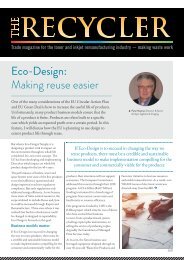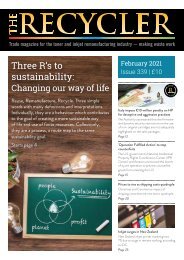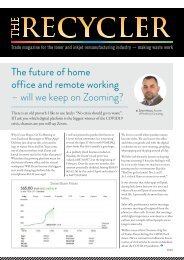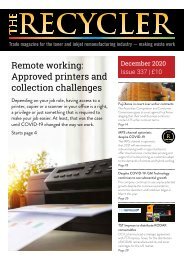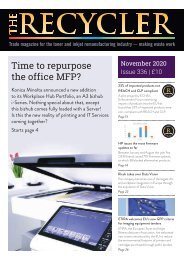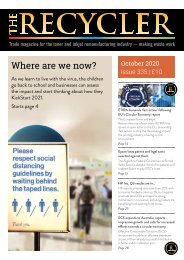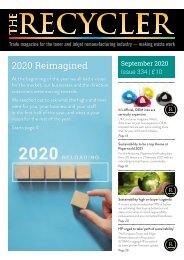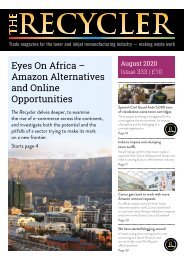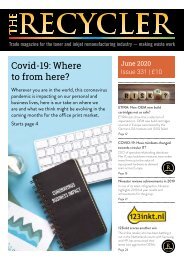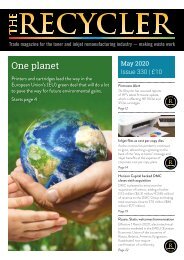Wide Format news 1-2017
You also want an ePaper? Increase the reach of your titles
YUMPU automatically turns print PDFs into web optimized ePapers that Google loves.
Space recyclers<br />
The MakerBot 3D printing company, in partnership with NASA, had a contest in 2014 called the MakerBot<br />
Mars Base Challenge, seeing designs for Mars 3D-printed habitat for astronauts. This design by Noah<br />
Hornberger won first prize<br />
September.<br />
Structures are also contemplated for earth habitat. The UN<br />
estimates that approximately three billion people will need<br />
housing by 2030. Italian engineering company WASP has<br />
constructed a 40 by 20 foot (approximately 6 by 12 metre) 3D<br />
printer that layers clay and builds houses. The project, consisting<br />
of a metal frame suspending a nozzle, is expected to help solve the<br />
global housing crisis with sustainable materials.<br />
For now, actual printers capable of 3D printing in zero-gravity<br />
are smaller. The first zero-gravity printer from NASA/JPL partner<br />
Made in Space was launched on 21 September 2014 as part<br />
of a pack of experiments. The device, tested on a specially-made<br />
aircraft to simulate zero-gravity flight and sent to the International<br />
Space Station, built an ABS-plastic ratchet wrench later tested<br />
on the ground, but proved its value in building tools and parts as<br />
second-generation zero-gravity 3D printers are being devised.<br />
“We are actively researching traditional methods and novel<br />
techniques that use extraterrestrial regolith simulants as feedstock<br />
for additive manufacturing,” said Brad Kohlenberg, Business<br />
Development Engineer for Made In Space, based in Mountain<br />
View, California. “We expect these efforts to help in the overall<br />
goal of making humanity a multi-planetary species. Ultimately,<br />
our participation towards that end could take many forms.”<br />
The Additive Manufacturing Facility by Made in Space was<br />
installed at the International Space Station in April 2016, and this<br />
3D printer will print with a wide range of polymers, is designed<br />
to last the entire lifetime of the space station, and is commercially<br />
available for any customers on Earth who wish to get hardware<br />
into space.<br />
Now that Made in Space has demonstrated technical ability<br />
and built relationships with partners, Kohlenberg said “we are<br />
looking to finally do the things we dreamed about when we started<br />
the company - building the necessary infrastructure for human<br />
spaceflight, in space. That infrastructure could entail everything<br />
from on-demand satellites and habitats to space elevators and<br />
kilometre-scale colony ships.<br />
“As these manufacturing technologies become more<br />
sophisticated and as we reach further away from Earth, Made<br />
In Space imagines a future in which advanced in-situ resource<br />
utilisation and additive manufacturing techniques allow us to use<br />
the resources we find out in space, rather than having to bring<br />
everything we need with us, allowing us to live sustainably and<br />
permanently off-world”.<br />
Pat Carey, Vice President of Go-to-market Strategy and<br />
Programmes for Stratasys, based in Eden Prairie, Minnesota,<br />
says any technology goes through goes through a curve of early<br />
adopters, then mass adoption, which becomes more affordable<br />
because of the volume. All technology follows the same curve, he<br />
said, and with 3D printing, “we’ll follow that same curve and there<br />
will be innovations we can’t imagine that will come out”.<br />
A recycling project called R3DO is a material reclaimer by<br />
Made In Space to reuse material for printing a 3D-printed object<br />
when the original objects breaks or is obsolete. JPL’s Soderstrom<br />
saw similar projects at an electronics show about three years ago:<br />
“In order for us to be able to print in space, we have to be able<br />
to recycle the material…that’s going to be a key to the future,<br />
especially in space.”<br />
Reprinting parts<br />
The recent movie, The Martian, starring Matt Damon, showed<br />
the need for parts in space. “When things go wrong and all of a<br />
sudden, you need something, how do you get it in space?”<br />
Soderstrom said. “It’s not an easy thing. You’ve got to have a<br />
launch vehicle; you have to know what you need, and by that time,<br />
days and days have gone by. What if you could just reprint that<br />
part? We’ve demonstrated that with NASA using Made In Space.<br />
It’s usually made out of ABS plastic, but it shows that it’s possible<br />
to do that.”<br />
It will mean better handling emergencies with speed, he said,<br />
adding: “It’s extremely important for logistics.”<br />
Kohlenberg said ongoing developments that will make 3D<br />
printing more practical on earth are the same things that will make<br />
An artist’s conception of a Mars base (NASA/JPL public domain)<br />
©<strong>2017</strong> The Recycler www.therecycler.com Page 2





